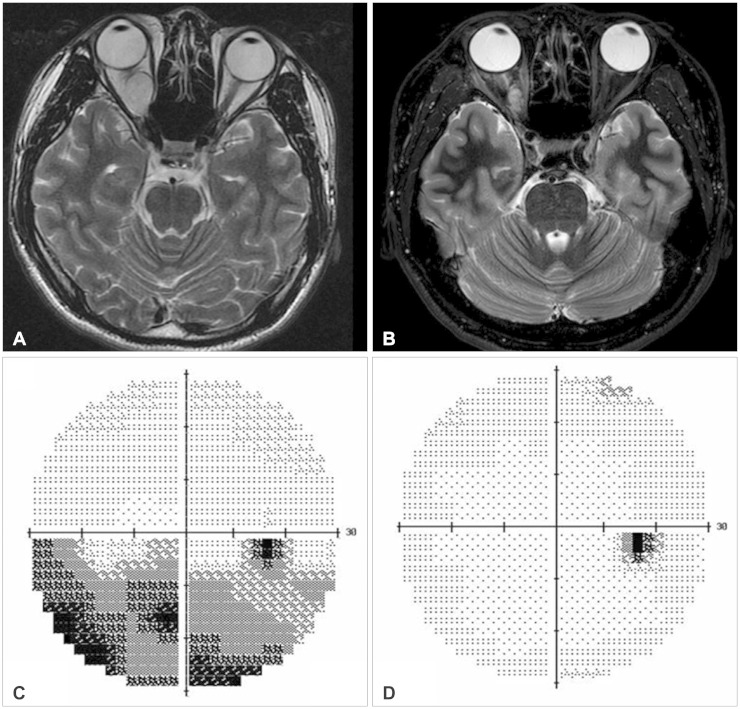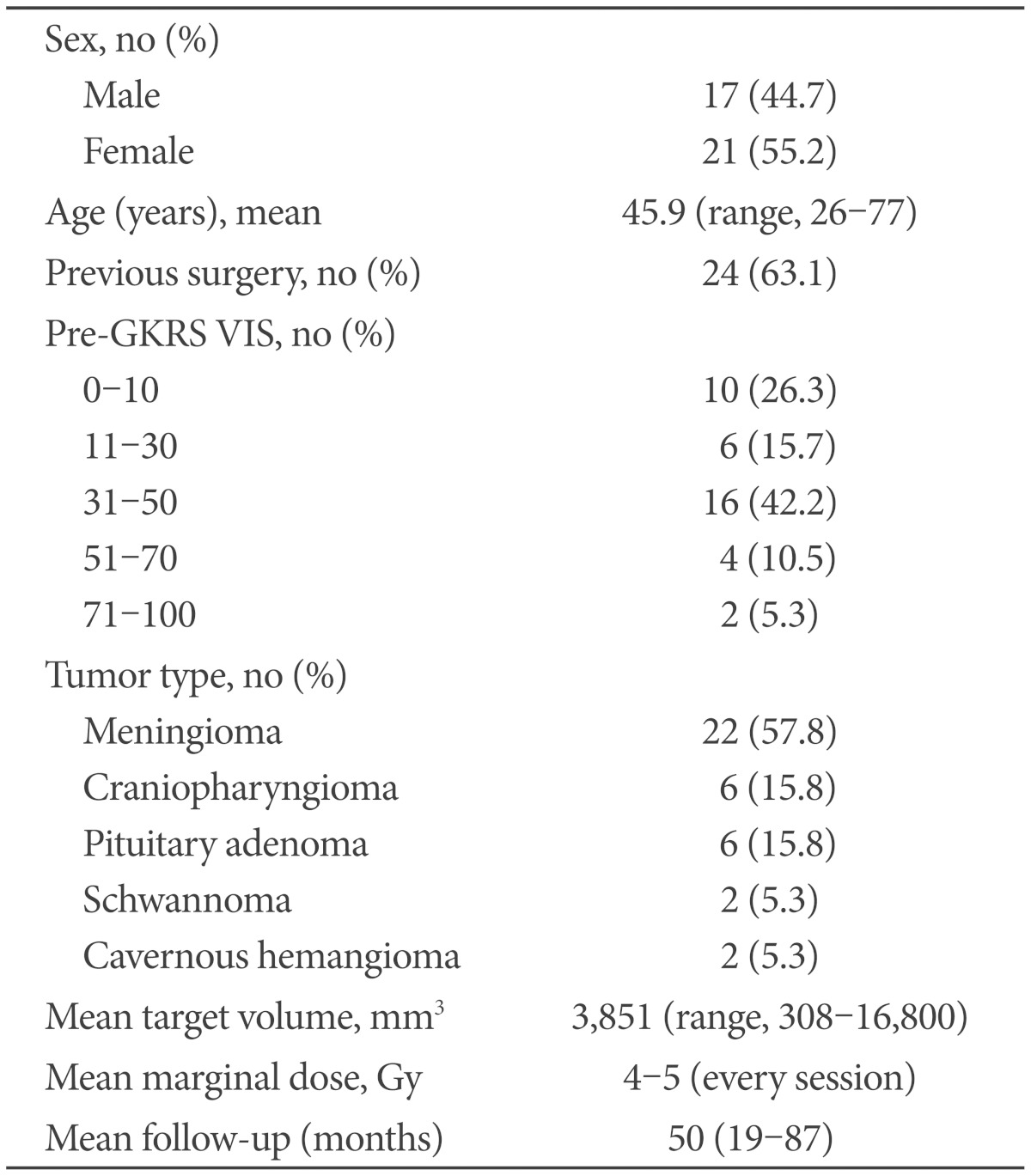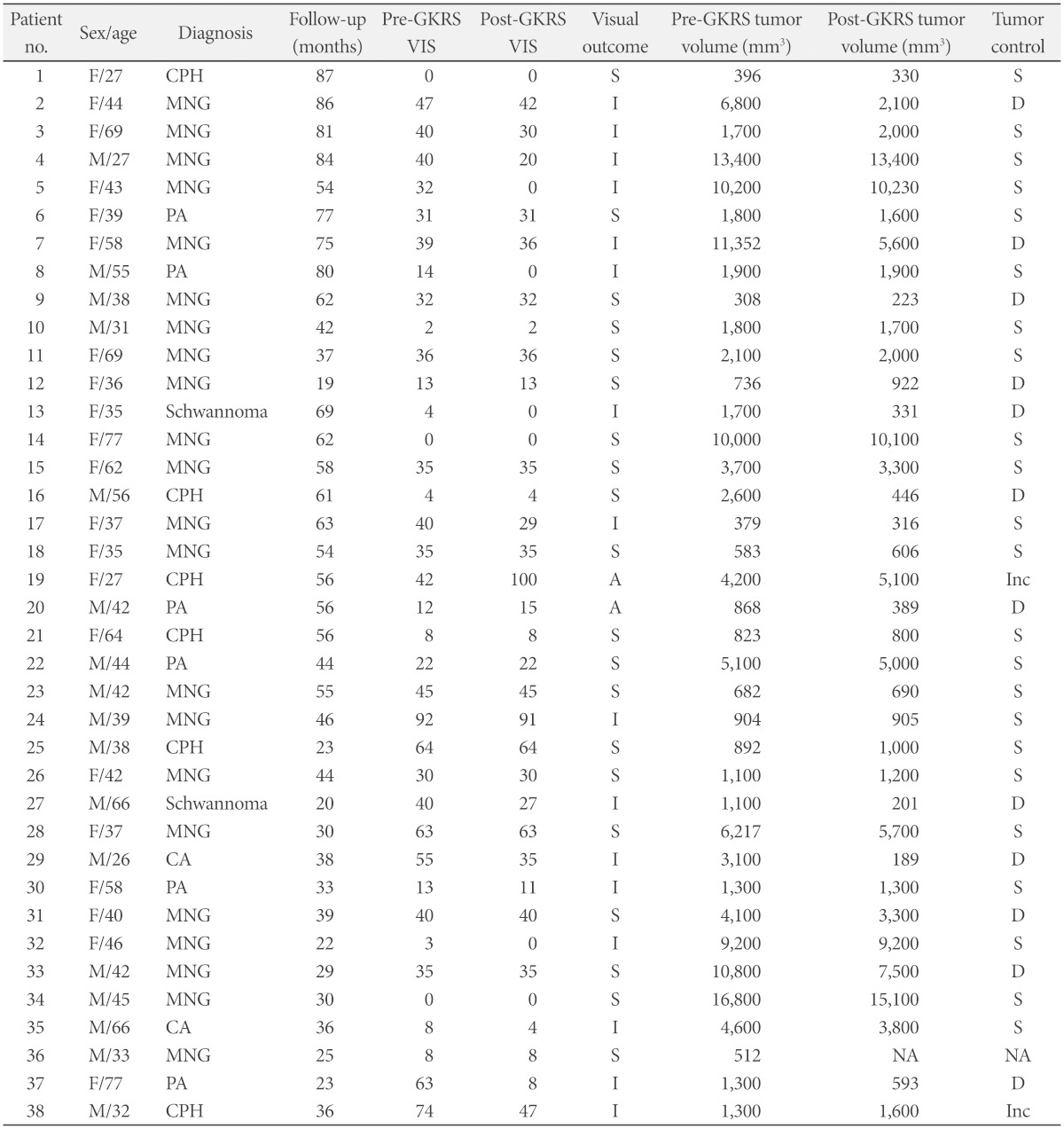1. Adler JR Jr, Gibbs IC, Puataweepong P, Chang SD. Visual field preservation after multisession cyberknife radiosurgery for perioptic lesions. Neurosurgery. 2006; 59:244–254. discussion 244-54. PMID:
16883165.

2. Borden JA. Treatment of tumors involving the optic nerves and chiasm. Semin Ophthalmol. 2002; 17:22–28. PMID:
15513452.

3. Andrews DW, Faroozan R, Yang BP, et al. Fractionated stereotactic radiotherapy for the treatment of optic nerve sheath meningiomas: preliminary observations of 33 optic nerves in 30 patients with historical comparison to observation with or without prior surgery. Neurosurgery. 2002; 51:890–902. discussion 903-4. PMID:
12234395.

4. Friedman WA, Foote KD. Linear accelerator radiosurgery for skull base tumors. Neurosurg Clin N Am. 2000; 11:667–680. PMID:
11082177.

5. Estrada J, Boronat M, Mielgo M, et al. The long-term outcome of pituitary irradiation after unsuccessful transsphenoidal surgery in Cushing's disease. N Engl J Med. 1997; 336:172–177. PMID:
8988897.

6. Lee M, Kalani MY, Cheshier S, Gibbs IC, Adler JR, Chang SD. Radiation therapy and CyberKnife radiosurgery in the management of craniopharyngiomas. Neurosurg Focus. 2008; 24:E4. PMID:
18447743.

7. Pollock BE. Stereotactic radiosurgery of benign intracranial tumors. J Neurooncol. 2009; 92:337–343. PMID:
19357960.

8. McCord MW, Buatti JM, Fennell EM, et al. Radiotherapy for pituitary adenoma: long-term outcome and sequelae. Int J Radiat Oncol Biol Phys. 1997; 39:437–444. PMID:
9308948.

9. Movsas B, Movsas TZ, Steinberg SM, Okunieff P. Long-term visual changes following pituitary irradiation. Int J Radiat Oncol Biol Phys. 1995; 33:599–605. PMID:
7558949.

10. Paek SH, Downes MB, Bednarz G, et al. Integration of surgery with fractionated stereotactic radiotherapy for treatment of nonfunctioning pituitary macroadenomas. Int J Radiat Oncol Biol Phys. 2005; 61:795–808. PMID:
15708259.

11. Metellus P, Regis J, Muracciole X, et al. Evaluation of fractionated radiotherapy and gamma knife radiosurgery in cavernous sinus meningiomas: treatment strategy. Neurosurgery. 2005; 57:873–886. PMID:
16284558.

12. Kim JW, Im YS, Nam DH, Park K, Kim JH, Lee JI. Preliminary report of multisession gamma knife radiosurgery for benign perioptic lesions: visual outcome in 22 patients. J Korean Neurosurg Soc. 2008; 44:67–71. PMID:
19096695.

13. Fahlbusch R, Schott W. Pterional surgery of meningiomas of the tuberculum sellae and planum sphenoidale: surgical results with special consideration of ophthalmological and endocrinological outcomes. J Neurosurg. 2002; 96:235–243. PMID:
11838796.
14. Barbaro NM, Gutin PH, Wilson CB, Sheline GE, Boldrey EB, Wara WM. Radiation therapy in the treatment of partially resected meningiomas. Neurosurgery. 1987; 20:525–528. PMID:
3587542.

15. Goldsmith BJ, Wara WM, Wilson CB, Larson DA. Postoperative irradiation for subtotally resected meningiomas. A retrospective analysis of 140 patients treated from 1967 to 1990. J Neurosurg. 1994; 80:195–201. PMID:
8283256.
16. Taylor BW Jr, Marcus RB Jr, Friedman WA, Ballinger WE Jr, Million RR. The meningioma controversy: postoperative radiation therapy. Int J Radiat Oncol Biol Phys. 1988; 15:299–304. PMID:
3403313.

17. Salinger DJ, Brady LW, Miyamoto CT. Radiation therapy in the treatment of pituitary adenomas. Am J Clin Oncol. 1992; 15:467–473. PMID:
1449108.

18. Stripp DC, Maity A, Janss AJ, et al. Surgery with or without radiation therapy in the management of craniopharyngiomas in children and young adults. Int J Radiat Oncol Biol Phys. 2004; 58:714–720. PMID:
14967425.

19. Cantore WA. Neural orbital tumors. Curr Opin Ophthalmol. 2000; 11:367–371. PMID:
11148705.






 PDF
PDF ePub
ePub Citation
Citation Print
Print




 XML Download
XML Download